How to Choose the Right Office Furniture?
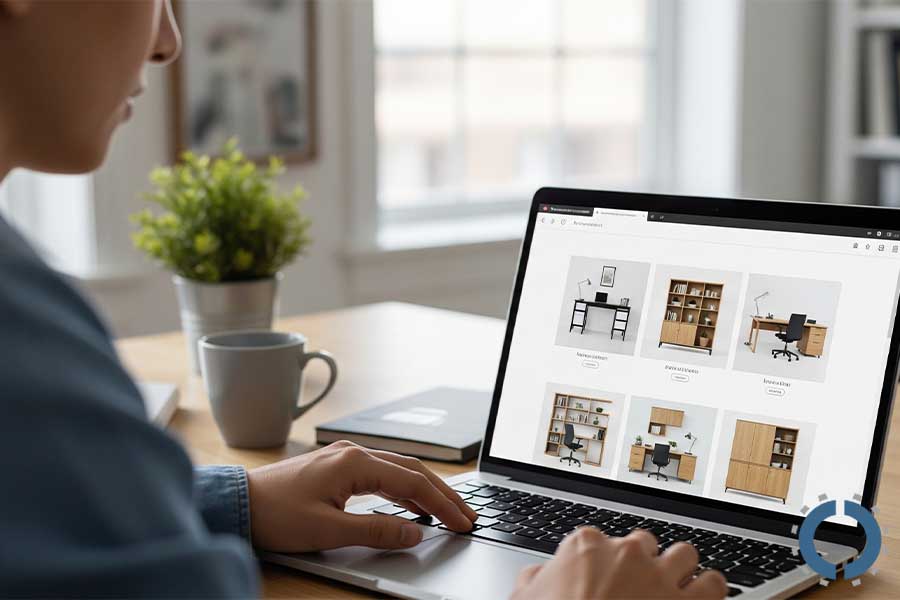
At first glance, choosing office furniture may seem like choosing a few tables and chairs.
But if we think a little deeper, we see that these choices can change the quality of daily work, the energy of the team, and the level of employee productivity.
Now we want to know how to choose the right office furniture.
Choose the right office furniture by focusing on ergonomics, durability, space efficiency, flexible modular design, aesthetics that match your brand, and budget. Prioritize comfort and functionality to improve productivity.
In 2025, your office should simultaneously meet several important needs, including a space for individual focus, an environment for teamwork, and comfort during long work hours.
On the other hand, with the increasing popularity of new trends such as hybrid working, the importance of employee health, and space flexibility, modern office furniture Houston has become more vital than ever.
You might be asking yourself right now: Which chairs are really good for long-term work?
How practical are modular desks?
Or what trends are worth paying attention to in 2025?
In this article, we answer exactly these questions.
In this comprehensive guide, we explore why ergonomics, design style, sustainability, 2025 trends, and proper layout are important to having a modern and efficient office.
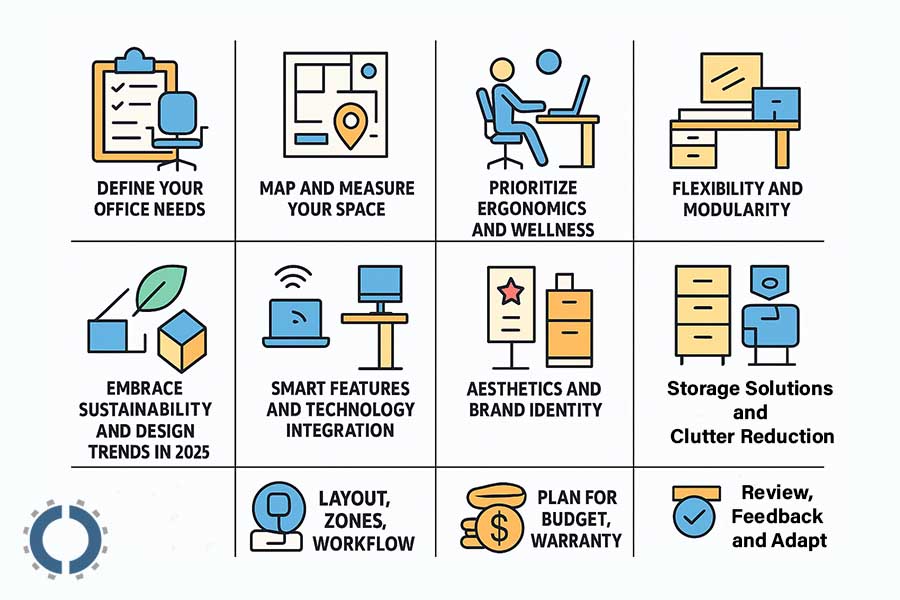
You Might Also Enjoy: How to Organize Office Furniture in 2025?
1. Define Your Office Needs
- Assess your work model: In the first step of how to choose the right office furniture, you should ask yourself what your team’s work model is.
If everyone on your team is in the office every day, you’ll need more fixed desks and chairs.
In a hybrid work model, it is very practical to have hot desks or modular furniture that can be configured for different numbers of employees on different days.
If your business is one where most work is done from home and the office is only a place for occasional meetings, you may need more meeting rooms, small spaces for team collaboration, or a lounge for meeting clients instead of lots of desks.
- Key questions: To more accurately determine your needs, it’s best to ask yourself some questions.
Which employees really need a fixed desk?
Does your team need a collaborative space?
Do you need to have private or semi-private spaces, like private office cubicles?
- Team Size and Future Growth: One of the common mistakes businesses make is that they only consider today’s needs.
However, you should also anticipate the potential growth of the team.
If you expect your team to grow in the next year or two, it’s best to choose furniture that is expandable and flexible.
For example, instead of buying lots of fixed desks, you can get modular desks that can be connected or separated as needed.
Or buy office seating Houston that is of high quality and durability so that it will last in the long run.
2. Map and Measure Your Space
- Precise measurements: The next step in how to choose the right furniture is to know the actual dimensions of your office.
Carefully measure the length and width of the room or hall.
This information will help you know how many tables or chairs can actually fit without making the space feel cluttered.
Also, measure the ceiling height because some furniture or shelves require a specific height.
Consider the location of windows and try to place desks near natural light.
The location of power outlets and network ports is also very important.
- Traffic Flow and Activity Zones: An office is like a city map, where the routes of travel and centers of activity must be clearly marked.
Identify the main routes for employee traffic so that furniture does not block the way.
Separate important spaces such as meeting rooms, reception areas, break areas, and work desks.
- Tools and Software: To get a better idea of the space, you can use simple design software before purchasing office furniture.
This allows you to see how the furniture will fit in the space before you buy.
You can even design several different scenarios and then choose the best one.
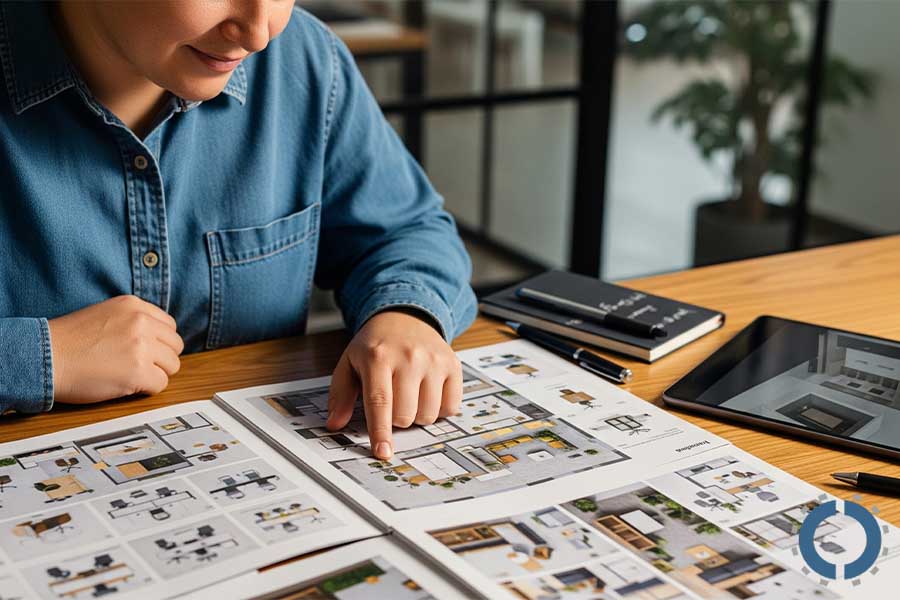
You Might Also Enjoy: Top 15 Office Furniture Every Home Office Needs
3. Prioritize Ergonomics and Wellness
- The importance of ergonomics: Ergonomics means designing furniture and work tools that fit the human body.
Sitting for long periods of time in an uncomfortable chair can cause strain on your back and neck.
Ergonomics can help minimize this problem.
Also, Ergonomic furniture prevents repetitive strain injuries.
Ergonomic furniture increases productivity because an employee who sits comfortably and is free from pain or fatigue will be more focused and perform their work with better quality.
- Features of ergonomic chairs and desks: To ensure that the furniture you choose meets ergonomic standards, you need to pay attention to several things.
Chairs should have adjustable height, lumbar support, movable arms, and swivel capability.
Office desks should be height-adjustable, have enough space for comfortable leg and knee placement, and a work surface suitable for a monitor and laptop.
- Wellness add-ons: In addition to chairs and desks, there are small but effective tools that have a big impact on employee health.
For example, a footrest reduces pressure on the legs and improves blood circulation.
The monitor arm provides height and angle adjustment of the monitor to reduce neck strain.
Anti-fatigue mats are also available for sit-stand desks, which are used to prevent leg and back fatigue during long-term work.
4. Flexibility and Modularity
- The necessity of adaptable office furniture: At this stage of how to choose the right office furniture, you should know that in hybrid offices, the number of employees present in the office is not the same every day.
Sometimes more space is needed for teamwork, and sometimes individual focus is a priority.
Flexible furniture allows you to quickly change layouts and dedicate a small space to several different uses.
- Types of Flexible Furniture: Modular desks are desks that can be connected or separated to create team or individual spaces.
Expandable storage space means shelves or filing cabinets that can be added to or removed from.
Height-adjustable desks are suitable for changing from sitting to standing and are used to increase health and flexibility throughout the workday.
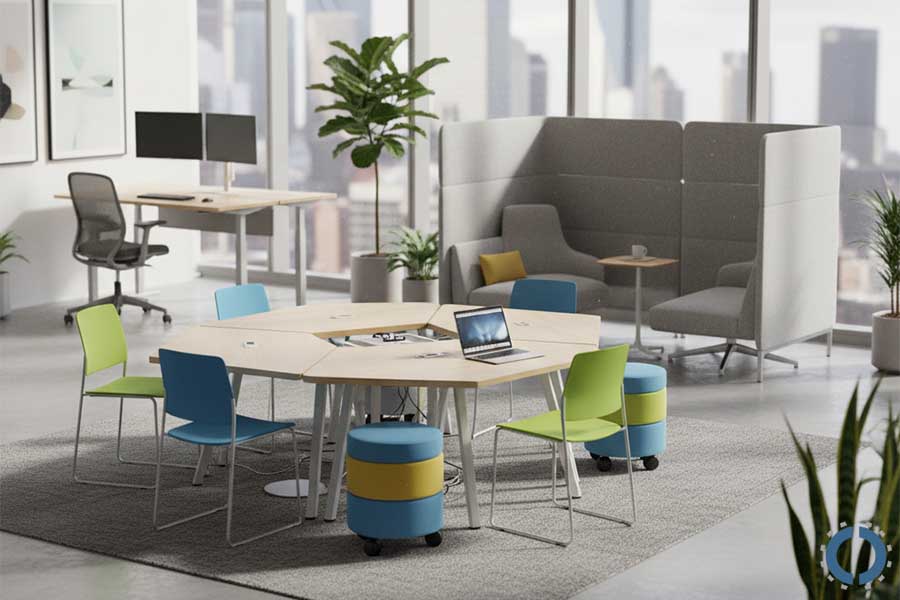
You Might Also Enjoy: Top 10 Office Furniture Stores in Houston: High Rated
5. Embrace Sustainability and Design Trends in 2025
- Sustainable Materials: In how to choose the right office furniture in 2025, companies will care more than ever about the environmental impact of their purchases.
Choosing furniture made from sustainable materials both helps the environment and demonstrates your brand’s responsibility.
Bamboo, recycled plastic, wood, and recycled metal are popular options.
- Popular 2025 Design Trends: Hexagonal desks are one of the 2025 trends that will create flexible layouts and easier collaboration between teams.
Biophilic Furniture, with designs inspired by nature, using plants, natural colors, and organic materials, is a good option for improving mood.
Another office furniture trend in 2025 is cafe-style seating, which provides informal spaces with comfortable chairs and communal tables for friendly interaction and creative meetings.
Modular setups, meaning furniture that can be easily reconfigured and adapted to the company’s changing needs, have also become very popular.
- Impact on Brand and People: Choosing sustainable furniture is not only an ethical decision but also creates a positive brand image.
Customers and partners will have more trust when they see that your company cares about the environment.
Employees feel more valued and belong in a healthier, more natural, and inspiring environment.
Also, in today’s world, companies that invest in sustainability are seen as ahead of their competitors.
6. Smart Features and Technology Integration
- Built-in cable management: Tangled cables and insufficient outlets make the office look cluttered and unprofessional.
For internal cable management, desks with hidden channels or special outlets for organizing wires can be a good option.
You can also use tables with wireless charging surfaces for mobile phones and gadgets.
- Height-adjustable smart desks: Sit-Stand desks with the ability to change height electronically, even with memory for each employee’s personal settings, are among the smart desks.
Some advanced desks track the number of hours you sit or stand and even remind you to change your position.
7. Aesthetics and Brand Identity
- Choosing furniture that reflects your brand personality: The office furniture you choose should be a reflection of your business’s personality and culture.
For example, modern office furniture with simple lines, neutral or bold colors, and minimal design is perfect for startups and tech companies.
Classic furniture with high-quality woods, formal furnishings, and warm colors is suitable for law firms, finance firms, or traditional brands.
Creative furniture with cheerful colors, unconventional furniture, and inspiring spaces are suitable for advertising, design, and art agencies.
- Balancing style with functionality: Sometimes, when choosing the right office furniture, we get so caught up in appearance that we forget about functionality.
To avoid this mistake, always ask: Is this furniture not only beautiful, but also comfortable and functional?
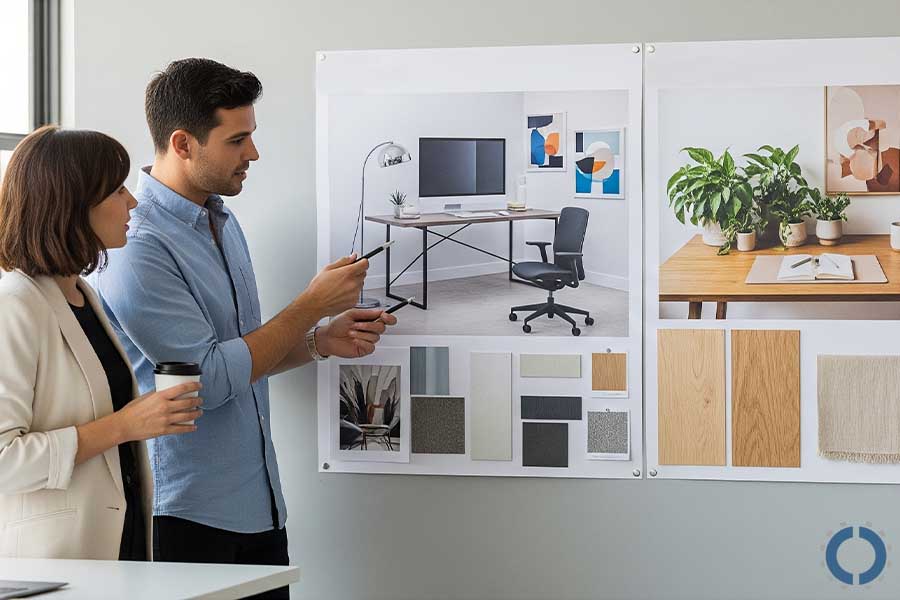
You Might Also Enjoy: The Cost of Tariffs On Your Office Furniture Project in 2025
8. Storage Solutions and Clutter Reduction
- Smart Storage Options: To ensure that everything has a specific place, it is better to use modern storage systems.
Vertical cabinets are a good option for making maximum use of the room’s height and storing documents or items.
Also, drawers under the table are for small, personal items that should not be scattered on the table.
You can use wall shelves for books, files, or light decorations without taking up floor space.
- Multi-Purpose Furniture: One of the best ways to save space is to use furniture that has multiple uses at the same time.
For example, benches with built-in storage, folding or extendable tables, demountable walls, and smart partitions are among these items.
9. Layout, Zones, and Workflow
- Creating Distinct Areas: A modern office in 2025 should be designed in such a way that all departments are separate and distinct.
Focus Zones are quiet environments intended for individual work and projects that require deep concentration.
Collaboration Hubs are team rooms or group desks designed for meetings and brainstorming.
Relaxation Spaces are areas with comfortable or cafe-style seating intended for short breaks or informal interaction.
- Effective Workflows: A design firm needs open spaces for team collaboration as well as small rooms for individual focus.
On the other hand, a tech startup needs modular desks in the center for daily work and a cafe lounge for informal meetings.
10. Plan for Budget, Warranty, and Longevity
- Spending Priorities: In how to choose the right office furniture, ergonomics and comfort are top priorities.
Because it directly affects the health, energy, and productivity of employees.
The second priority is aesthetics and attention to your business brand.
- Budgeting for Long-Term Value: A common mistake most businesses make is that companies look for the cheapest options.
But in practice, cheap furniture breaks down faster, increasing replacement or repair costs.
High-quality furniture may be more expensive, but it will last longer and be more affordable overall.
- Warranty, Brand, and Durability: A valid warranty gives you peace of mind that you won’t pay extra in the event of a breakdown or problem.
High-quality brands usually have more stringent testing and meet international standards.
In addition, choosing solid woods, stainless steel, and scratch-resistant finishes will ensure that the furniture will last for years without losing quality.
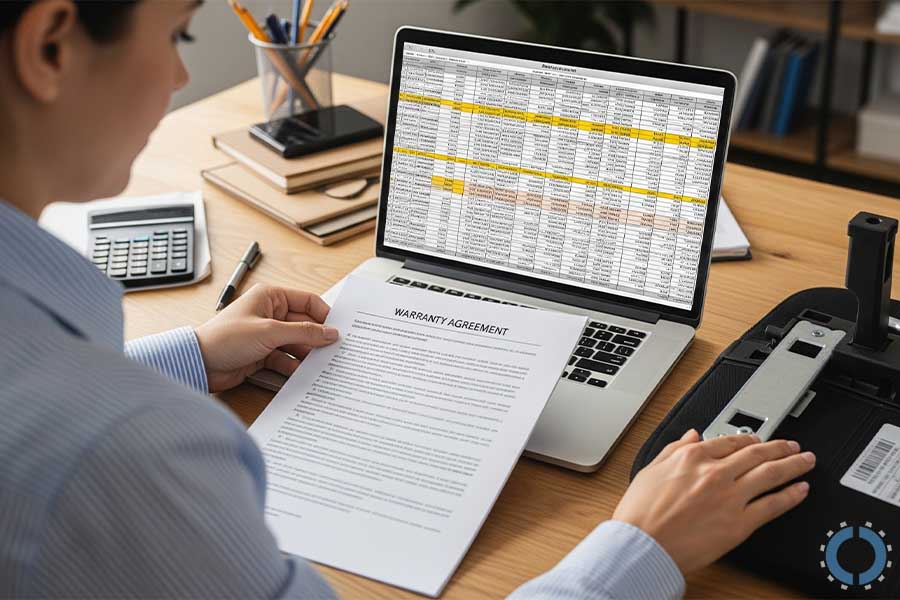
11. Review, Feedback, and Adapt
- Gathering Employee Feedback: One of the important things you should do is to ask your employees for their opinions after installing and setting up the furniture.
Ask them if the chairs are comfortable.
Are the office desks suitable for the type of work they do?
Are the spaces suitable for collaboration or concentration?
- Adapting Layouts to Team Needs: Over time, teams grow, projects change, and work styles evolve.
So choose modular or movable furniture so you can easily change the layout.
It is better to make the changes gradually and experimentally to see which model has the most efficiency.
- Ongoing Adjustments: If you want to have a successful business, you need to review the space from time to time and make sure it aligns with the organization’s goals.
If not, you should know that you don’t need to make major changes, and sometimes small changes like moving desks, adding new chairs, or improving lighting can have a big impact on employee satisfaction.
Conclusion
Choosing office furniture in 2025 means creating a space that both increases productivity and maintains employee health.
In the article How to Choose the Right Office Furniture in 2025, we saw that several important principles are particularly important in decision-making.
Now is the time to take another look at your workspace, assess the real needs of your employees, and choose furniture that suits your office and needs.
This choice should give the people within it more power and energy to work and increase their productivity.

John Ofield is the owner of Collaborative Office Interiors. Houston’s trusted source for modern and commercial office furniture, office cubicles, demountable walls, office desks and tables, and complete workspace solutions. With more than 40 years of experience, he combines deep product knowledge with hands-on space-planning expertise to create ergonomic, productivity-focused work environments for businesses across Southeast Texas.


